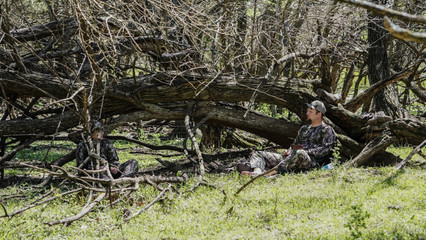Turkey Hunting Tips: Being One Step Ahead
Posted by Drew Palmer on Feb 25th 2020
Talk to any turkey hunter who’s ever been outwitted multiple times by a bird, and it’s like talking to a superhero who is trying to defeat their greatest foe. Those birds almost never die, as the spirits of those sought after longbeards drift through the trees and over the dinner table.
The more you chase gobblers in the springtime, the more you become obsessed with understanding their behavior and staying one step ahead.
Every hunter has that buddy who claims turkeys are a dumb, peanut-brained bird and likes to tell the story of the turkey that came to him while he sat on the ground in blue jeans mouth calling yawt yawt, before he shot the turkey at 10 steps.
It’s true some days. But if you chase these beautiful birds long enough, you’ll get the soles on your shoes burned off once or twice and your pride cut in half.
I used to put a lot of emphasis on being within eyesight of birds; it helps to know what I’m calling at and what they are doing.
But even if you can see them at 9:30 a.m., it doesn’t mean they are in good position to hunt. Being in the middle of a field with six hens is a common thing; but once the sun gets high, they are almost always going to split up. Hens go to nest, and gobblers go to strut in the shade.
I’ve changed my tactics and thought process. I’ve spent time learning more about their habits and preferences and thinking about what it’s like wearing a black sweater covered in feathers.
Nowadays, if I can’t hear a turkey gobble, I don’t lose as much confidence as I used to. I think of where they could be or what they are doing when I look at a property that I know has birds.
Getting to those places before they do has put more than a few notches on my gun stock.
I look for hollers, bowls, nooks, meadows, and any other small shady spot out of the wind that a gobbler can spin around in all afternoon. They are nearly impossible to call out of these places and all too hard to see there. Walk into them at noon and there is a decent chance you’ll see that dead red head with a high snood putting away from you.
My favorite setup is a couple of hens and a full strut jake fan. This usually works perfectly because you’ve busted into their bedroom and the jake strutter gets their gears all tied up.
Using the strutter is sometimes a hero or zero, but I’ve had so much success in the sun with it that I’ll live and die by it. Adding the jake fan or cut up tom fan into a jake fan seems to seal the deal, giving those birds confidence this is a fight they can win.
The box call is another must-have, as the sound of it can rip through a canyon for nearly a mile.
I once saw my friend Preston Pittman take out one of his prototype “boat paddles” and yelp at a couple gobblers over 500 yards away. It was blowing so hard that you couldn’t have heard a bird gobble at 100 yards, much less half a mile.
I watched the birds gobble through a spotting scope, and 45 minutes later they were in half strut coming down into a bowl behind a pond into gun range. Dead.
Sun and wind make hunting tough; that’s no secret. But hunting with your head and not your eyes can put you in the right spot, one step ahead.




